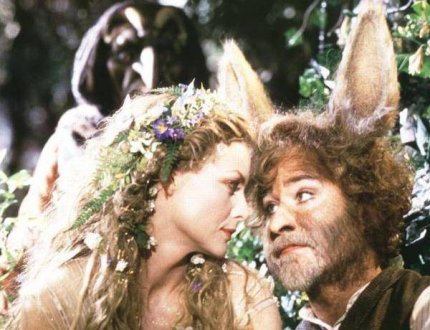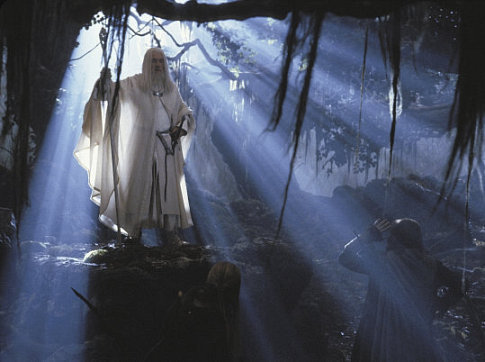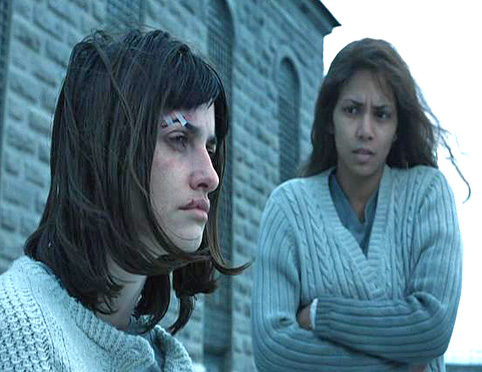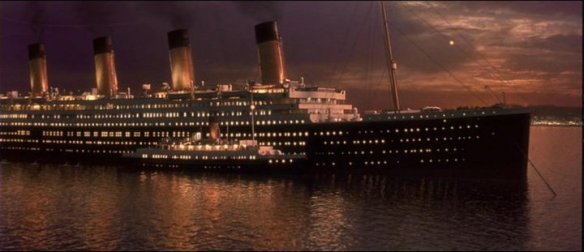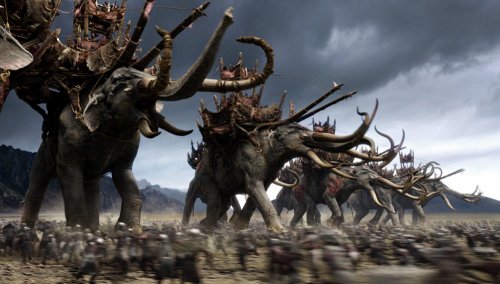
An olliphant never forgets.
(2003) Fantasy (New Line) Elijah Wood, Sean Astin, Andy Serkis, Ian McKellen, Viggo Mortensen, Orlando Bloom, John Rhys-Davies, David Wenham, Karl Urban, Dominic Monaghan, Billy Boyd, Liv Tyler, Miranda Otto, Bernard Hill, John Noble, Sean Bean, Christopher Lee,Thomas Robins, Hugo Weaving, Paul Norrell, Lawrence Makoare. Directed by Peter Jackson
After a long wait at long last the conclusion of Peter Jackson’s version of the epic J.R.R. Tolkein-penned trilogy The Lord of the Rings came upon us, and it was everything we hoped it would be – although had it come out 10 years later it would have been split into two movies in order to maximize profits although in this case I wouldn’t have minded so much.
The movie opens with a flashback, as we see how Smeagol (Serkis) took possession of the ring (or vice versa), murdering his friend Deagol (Robins) for it. Smeagol slinks into the wilderness, gradually losing his soul and becoming the creature known as Gollum.
Frodo (Wood) and Sam (Astin) are being led for a secret way into Mordor by Gollum unaware that the wicked creature intends to lead them into a trap. The lembas bread which has sustained them is running low, and Sam is rationing it. They need to climb a nearly vertical rock face in order to enter the tunnels that will take them into Mordor. However, Gollum displays his treachery, using the ring’s hold on Frodo and some strategically placed lembas crumbs to drive a wedge between Frodo and Sam, which leads to Frodo telling the weeping Sam to go home.
Meanwhile, the other heroes of the fellowship have no time to rest on their laurels after the events which crowned The Two Towers. Gandalf (McKellen), Aragorn (Mortensen), Legolas (Bloom) and Gimli (John Rhys-Davies) ride for Isengard to take on Saruman (Lee), only to find out that the Ents have done it for them. They discover the hobbits Merry (Monaghan) and Pippin (Boyd), happily smoking their beloved South Farthing pipeweed and munching away on the spoils of Isengard’s larder.
Once again, the group separates, with Gandalf and Pippin going to the city of Minas Tirith to assist Gondor in the battle to come. Aragorn, Legolas, Merry and Gimli return to Rohan to await word from Gandalf and also convince King Theoden (Hill) to aid Gondor in their time of need, although he is loathe to do so since Gondor provided him with no assistance when his people needed it. When Gandalf and Pippin arrive at Gondor, Gandalf warns Pippin not to tell Denethor (Noble), the Steward of Gondor, of the death of his son Boromir (Bean) which Pippin witnessed.
However it turns out that Denethor already knows and the news has unhinged him. Pippin offers up his services to placate the half-mad ruler. Denethor refuses Gandalf’s plea to light the signal fires to call on aid from Rohan, but Pippin lights the fire anyway, and Theoden determines to go to Gondor’s aid. Eowyn (Otto) pleads to go with her uncle, but he refuses, asking her to stay behind to lead Rohan if he doesn’t return (he doesn’t expect to, knowing the numbers of warriors he brings will be inadequate). She disguises herself as a man and goes anyway, as does Merry, whom she pledges to look after.
Boromir’s brother Faramir (David Wenham) can do no right in the eyes of his father, which is further complicated when Osgiliath, the fort he is charged to defend, is overrun by a numerically superior force of Orcs. Denethor orders Faramir and his company back to retake the fortress, even though Faramir knows that neither he nor his men will survive the attempt. That proves to be the case, as Faramir’s body is returned to Minas Tirith and Denethor completely loses it, extolling his men to abandon their posts and flee for their lives as an enormous army of orcs and mercenaries riding elephantine war beasts reach the gates of the city and begin to knock on the gates. To Pippin’s further horror, Denethor becomes determined to cremate Faramir’s body, even though as Pippin discovers, Faramir is still alive.
In the mountains of Mordor, Gollum springs his trap on Frodo leading the defenseless hobbit into the lair of a giant spider named Shelob, who attacks Frodo and at last, poisons him with her venom, wrapping the hapless hobbit in web for eventual dining. Fortunately Sam arrives in the nick of time to fight off Shelob, but can’t stop a small band of Orcs from taking Frodo’s inert but still-living body. Sam manages yet another dramatic rescue and the two emerge from the mountains, only to find that there are at least 10,000 Orcs encamped between them and Mount Doom.
As the force from Rohan encamps in the mountains, Elrond (Weaving) appears, bearing the re-forged sword of the King that had once defeated Sauron and gives it to Aragorn, urging him to take up the role he had been born to play: King of Gondor, heir to Isildur and the great kings of legend. Knowing that his love Arwen (Tyler), daughter of Elrond, is dying as Sauron grows stronger, having refused to leave Middle Earth with the rest of elvenkind, Aragorn reluctantly accepts the mantle he has avoided all his life. He, Gimli and Legolas go into the mountain to persuade an army of the dead to assist them. This army, led by the King of the Undead (Norrell), once broke oaths to the King of Gondor and were cursed for it. They will respond only to the King of Gondor, and when Aragorn reveals his sword, he has the allies he seeks.
Not a minute too soon, either. Minas Tirith is in the process of falling, despite the heroics of Gandalf. The mercenaries, orcs and nazghul are in danger of overrunning the city when Theoden and the Rohirrim arrive. They are able to hold off the hordes, but at great cost. Aragorn’s arrival with the army of the dead, however, saves the city. Once this is done, Aragorn releases the dead to their final rest.
All is not over, however. Aragorn knows that Frodo cannot hope to succeed with all the Orcs still encamped in Mordor. The forces of the Fellowship must make a desperate attempt to give Frodo and Sam the time they need to make it to Mount Doom and destroy the Ring in the fires that it was forged in. But Frodo may not want to destroy the Ring after all and Gollum is still lurking about with a part to play in the final dénouement.
As with the first two movies, The Lord of the Rings: The Return of the King is absolutely breathtaking visually. The city of Minas Tirith is like a wedding cake in concrete, beautiful and imposing. On the flip side, the computer-generated Shelob is terrifyingly realistic; you could almost imagine her crawling around the dark places in your home town. A lot of sensitive people are going to have some nasty nightmares as a result of her.
The battle scenes are impressive in their scope. Thousands of computer-generated warriors move in tandem with the real actors and extras that were employed in the battles of Pelennor Field and of the Black Gate. Even the most jaded of moviegoers will be amazed and enthralled by what Peter Jackson has brought to life onscreen.
Mortensen gives a performance for the ages; his charisma and rugged good looks would earn him further starring roles, although I daresay he’ll probably always be remembered as Aragorn. Still, in many ways this movie is Sam’s story more than anyone else’s. He shows growth as a character, becoming the equal of any of the heroes who have garnered more press. It is Sam who provides the movie’s emotional payoff.
Elijah Wood’s Frodo is a curious case. Although ostensibly the focus of the movie, Wood is curiously detached. It’s very hard at times to fathom who Frodo is, although, to be fair, Frodo is undergoing drastic changes at the hands of the Ring. It’s hard to imagine being less interested in Frodo than you are in Merry or Pippin, but that is the case here. Wood does a pretty good job, but that’s not good enough to stand out in a cast that performs so magnificently.
Orlando Bloom also showed the makings of a big star, although Legolas is not really at the fore much in the trilogy; when Legolas is given the spotlight, however, Bloom shines. Andy Serkis provides Smeagol and Gollum both with humanity; although treacherous and conniving, you wind up feeling the pity for the character as both Frodo and Bilbo had, which is crucial for the story. The supporting cast of Wenham, Otto, Urban, McKellen, Monaghan and Boyd in particular all added luster to their résumés here.
Roger Ebert criticized Return of the King and the trilogy overall as having a “silly story,” which is one of the few times I have disagreed with him quite this vehemently. The story of the trilogy is the story of man’s own ability to grow and change. Written at the dawn of the atomic era, it ascribed hope that we could overcome the desire to use an awesome weapon, and conquer the forces of darkness and despair. Not silly at all, I find it a powerful story that has as much meaning in my everyday life as do some of the smaller films Ebert prefers.
The Lord of the Rings trilogy has an honored place in cinematic history for groundbreaking visuals, and passionate vision. Return of the King is the best of these movies, not only because it should be, as the payoff of the trilogy, but because it also is so well-made and the performances well-given. Once you get past the eye candy, all you are left with is the performances and in that, you will not find a better ensemble than this one. It is to date the only movie nominated for more than ten Oscars (eleven to be exact) to win every award it was nominated for, and deservedly so. It is one of three films to win eleven Oscars, the most in the history of the award. I don’t know how much more honored a film can get.
I viewed the conclusion of this beloved trilogy with a mixture of awe, wonder, sadness and satisfaction. I am sorry the trilogy is now complete, but look forward to the works of Peter Jackson, Viggo Mortensen and the rest of the cast. There is an emotional epilogue in which some of the main characters of the trilogy take their leaves – not only from the tale, but from those of us who have followed the story from day one. It is a most satisfying ending.
WHY RENT THIS: An amazing piece of film-making; it earned every Oscar it got and more. It will stand as one of the first true classics of the 21st century.
WHY RENT SOMETHING ELSE: You find this a “silly story.” Roger Ebert, shame on you!
FAMILY MATTERS: The battle sequences are pretty grisly in places but I cannot emphasize enough just how frightening Shelob is as a creature. If you have a fear of spiders or are particularly sensitive to monsters, be warned that Shelob is as scary a creature that has ever been put to film.
TRIVIAL PURSUITS: Peter Jackson has an irrational fear of spiders and modeled Shelob on two of the species he fears the most.
NOTABLE HOME VIDEO FEATURES: There have been several different releases of varying size of the film and there are so many different and fascinating features that listing them all for each edition would take up far too much space here. Suffice to say that you will essentially have a choice of two different versions of the film; the two hour-plus theatrical release and the nearly four hour extended director’s cut. The latter only last month arrived as part of a box set to take advantage of the renewed Middle Earth fervor generated by the Hobbit trilogy, the first film of which arrives at Christmas this year. Even the bare bones DVD editions have plenty of wonderful features so that no matter which version you choose you’ll have plenty of things to occupy many hours of viewing time but the extended edition Blu-Ray has enough special features (some brand new) to make even the hardiest of Frodo fans faint.
BOX OFFICE PERFORMANCE: $1.1B on a $94M production budget; the movie made ten times what it cost, easily a blockbuster.
COMPARISON SHOPPING: Gone With the Wind
FINAL RATING: 10/10
NEXT: Iron Man

